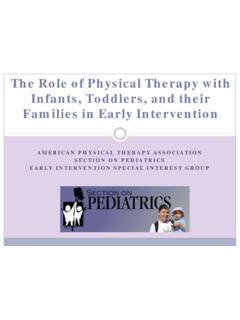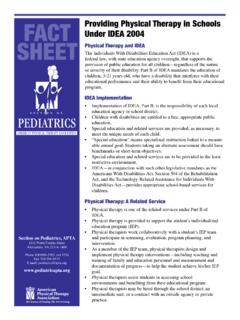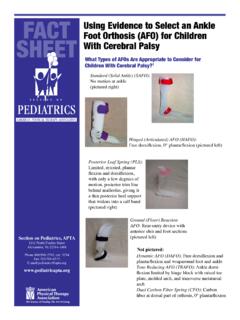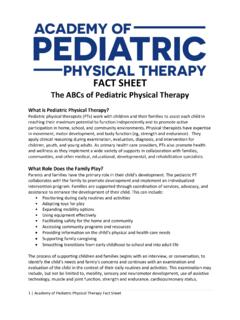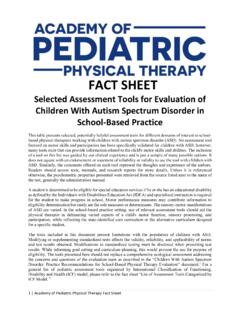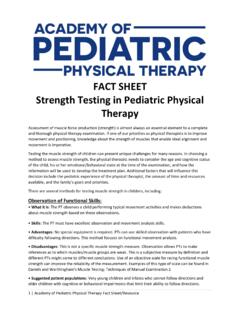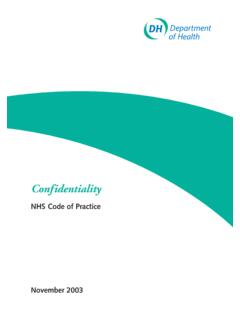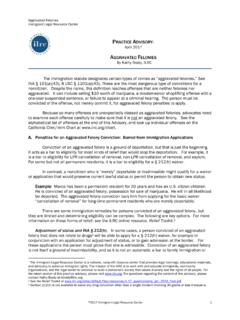Transcription of School-Based Physical Therapy: Conflicts Between Individuals …
1 1 | Academy of Pediatric Physical Therapy Fact Sheet/Resource School-Based Physical Therapy: Conflicts Between Individuals With Disabilities Education Act (IDEA) and legal Requirements of State Practice Acts and Regulations School-Based Physical therapy is a unique practice setting, governed by federal, state, and local mandates. Clients are students (ages 3 to 21 years old) with a myriad of complex and challenging conditions, including developmental delays, cerebral palsy, progressive neuromuscular disorders, autism, learning disabilities, and severe Physical and cognitive disabilities. School-Based Physical therapists (SBPTs) serve on Individualized Education Program (IEP) teams, which are comprised of teachers, other educational professionals, and parents.
2 The teams collaborate on decisions regarding provision of a variety of services, including Physical therapy. SBPTs deliver services to students and on behalf of students through direct intervention and/or consultation with school personnel on issues that require Physical therapist (PT) expertise. As related service providers, SBPTs must comply with the federal Individuals with Disabilities Education Improvement Act of 2004 (IDEA).1-5 However, they report ethical and practice challenges arising from Conflicts Between IDEA and their respective state practice acts, rules, and In January 2013, the School-Based Physical Therapy Special Interest Group (School SIG) of the Section on Pediatrics (SoP), American Physical Therapy Association (APTA), appointed a task force on state practice acts and regulations to examine these Conflicts and develop recommendations for addressing them.
3 In collaboration with the SoP s Early Intervention Special Interest Group (EI-SIG), we developed a survey to determine the extent to which these Conflicts affect both School-Based and early-intervention practice, with each SIG analyzing its results separately. We emailed the survey link to the 494 current members of the School SIG, and the SoP office emailed it to all 5,028 SoP members, of which nearly 37% practice in school settings. SBPTs from 39 states submitted 255 completed surveys, representing 52% of the School SIG and 14% of School-Based SoP members. An additional 87 respondents reported practicing in early- 2 | Academy of Pediatric Physical Therapy Fact Sheet/Resource intervention, hospital-based, clinic-based, or academic settings.
4 The results revealed that, among each of 5 identified issues listed below, 35% to 57% of SBPT respondents experience at least some conflict (See Table 1). Examination, Evaluation, & Reevaluation Documentation Physician referral Supervision of Physical therapist assistants (PTAs) Supervision of other educational personnel Table 1. Survey on Conflicts Between IDEA and State Physical Therapist Practice Acts/Regulations in School-Based Settings: January 2013 N = 255 Difficulties or Conflicts None Some of the Time Frequently Most of the Time Does Not Know Practice Act Examination/Evaluation/Reevaluation 27% 36% 13% 8% 16% Documentation 31% 36% 10% 11% 12% Physician Referrals 41% 30% 11% 6% 12% Supervision of PTAs 51% 22% 7% 6% 14% Supervision of Other Educational Personnel 41% 25% 6% 6% 22% Examination/Evaluation/Reevaluation The terms evaluation and reevaluation, as they relate to Physical therapy practice, present challenges for SBPTs.
5 IDEA mandates a timeline for initial evaluations and reevaluations to determine whether a student requires special education and related services. A PT s initial evaluation may be part of the process for determining eligibility or as a referral from the Individualized Education Program (IEP) team at a later date as team concerns arise regarding student In general, state Physical therapy practice acts require reevaluations every 30, 60, or 90 days. Under IDEA, reevaluations must be conducted every 3 years or when the IEP team identifies changes in the student s function, resulting in an earlier reevaluation. Re-evaluation, as it relates to IDEA 2004, is used to support a student s need for special education and related services, but not specifically Physical therapy.
6 Most students with IEPs have long-term disabilities or chronic conditions that may not show significant changes or responses to interventions within 30- to 90-day periods. Therefore, reevaluations, as defined by state practice acts, may not be necessary and could cause disruption in the educational program and provision of services. According to IDEA 2004, IEPs are reviewed and revised annually or more if needed. Writing lengthy evaluation/reevaluation reports at shorter intervals, along with IDEA s mandate for obtaining written parental permission, would add to the already excessive paperwork required of SBPTs. SBPTs should consult their state practice acts for further information. An example of language that addresses these challenges can be found in the Oregon Administrative Rules.
7 This document states that a PT must perform an evaluation when the individual is a child or a student eligible for special education, as defined by state or federal law, or eligible under Section 504 of the Federal Rehabilitation Act of 1973, and is being seen pursuant to the child s or the student s individual education plan, individual family service plan, 504 plan, or other designated plan of care, following the IDEA timeframe of routine reports and annual Some state practice acts define an 3 | Academy of Pediatric Physical Therapy Fact Sheet/Resource update simply as documentation of client response, progress toward achievement of goals, and justification for continued treatment on a timeline of every 30 to 180 days.
8 In those states, SBPT documentation of PT services rendered or IEP progress reports could meet the requirements of both IDEA and practice acts. SBPTs who find areas of conflict should advocate to their state boards to make changes that are appropriate for School-Based practice. Documentation Requirements for documentation in School-Based settings are challenging for SBPTs and add significantly to their workload, impacting service provision and caseload assignments. Frustration about paperwork has been described as one of the greatest professional challenges for SBPTs and an impetus for leaving School-Based Since requirements for SBPT intervention records are not stipulated in IDEA, local education agencies, supervisors, or SBPTs them-selves determine the format and extent of their documentation, usually basing it on requirements of their practice acts and guidelines of their professional organizations.
9 IDEA stipulates the IEP as the foundation for service delivery. Included is the special education eligibility classification, a description of the student s present levels of academic achievement and functional performance (PLAAFP). This incorporates measurable goals, methods for monitoring and progressing goals, related services to be provided (including Physical therapy), frequency and duration of those services, duration of the IEP, and other identified services. The IEP team collaborates in deter-mining whether the expertise of a PT is required to assist the student in special education. Goals must be discipline-free, measurable, and focus on the student s participation in the educational program.
10 The IEP may or may not suffice as the plan of care, depending on state regulations. PT intervention strategies are not documented in the IEP. Additional questions may arise from APTA s Guide to Physical Therapist Practice, Second Edition, which delineates Physical therapy examination, evaluation, diagnosis, prognosis, and plan of APTA s Defensible Documentation for Patient/Client Management states that PTs should document each PT session (including cancellations) and stipulates that the IEP may include the plan of However, the IEP rarely includes all the components of a Physical therapy plan of care as required for Medicaid reimbursement or as identified by these APTA documents.
